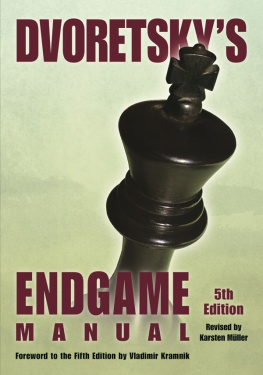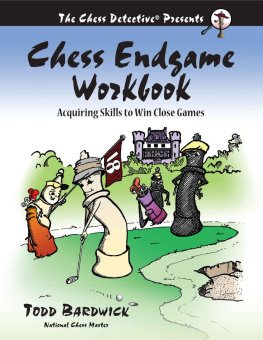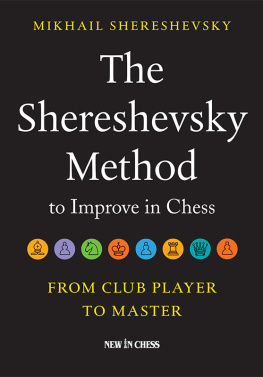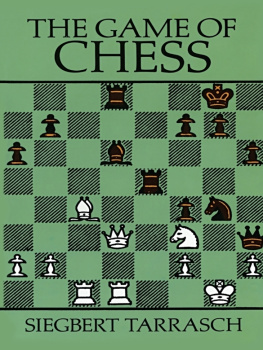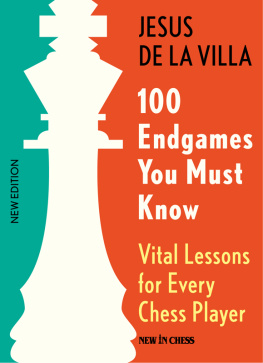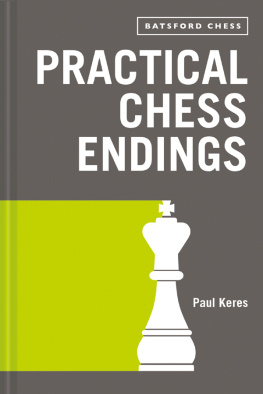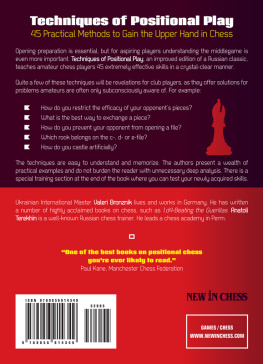(pgn) Modern Chess - Practical Rook Endgame
Here you can read online (pgn) Modern Chess - Practical Rook Endgame full text of the book (entire story) in english for free. Download pdf and epub, get meaning, cover and reviews about this ebook. genre: Home and family. Description of the work, (preface) as well as reviews are available. Best literature library LitArk.com created for fans of good reading and offers a wide selection of genres:
Romance novel
Science fiction
Adventure
Detective
Science
History
Home and family
Prose
Art
Politics
Computer
Non-fiction
Religion
Business
Children
Humor
Choose a favorite category and find really read worthwhile books. Enjoy immersion in the world of imagination, feel the emotions of the characters or learn something new for yourself, make an fascinating discovery.

- Book:(pgn) Modern Chess - Practical Rook Endgame
- Author:
- Genre:
- Rating:5 / 5
- Favourites:Add to favourites
- Your mark:
- 100
- 1
- 2
- 3
- 4
- 5
(pgn) Modern Chess - Practical Rook Endgame: summary, description and annotation
We offer to read an annotation, description, summary or preface (depends on what the author of the book "(pgn) Modern Chess - Practical Rook Endgame" wrote himself). If you haven't found the necessary information about the book — write in the comments, we will try to find it.
Unknown: author's other books
Who wrote (pgn) Modern Chess - Practical Rook Endgame? Find out the surname, the name of the author of the book and a list of all author's works by series.
(pgn) Modern Chess - Practical Rook Endgame — read online for free the complete book (whole text) full work
Below is the text of the book, divided by pages. System saving the place of the last page read, allows you to conveniently read the book "(pgn) Modern Chess - Practical Rook Endgame" online for free, without having to search again every time where you left off. Put a bookmark, and you can go to the page where you finished reading at any time.
Font size:
Interval:
Bookmark:
[Event "?"] [Site "?"] [Date "????.??.??"] [Round "?"] [White "General Introduction"] [Black "?"] [Result "*"] [Annotator "GM Grigor Grigorov"] [PlyCount "0"] [EventDate "2000.??.??"] [SourceVersionDate "2021.05.20"] {When all the pawns are on the same wing, an extra pawn is not enough to win the game. Every one of us has heard this phrase at least once in our career. Even though such statements can not be 100% true, they serve as a reference point. Indeed, drawish tendencies in such endings are considerable. That's why before starting my preparation for the current lecture, I was afraid that I will deal with more or less evident stuff. While selecting the material, however, I was surprised to see how often top-level grandmasters lose such endgames.
This was an indicator that things are not that simple. After presenting the basic must-know classical positions, I tried to illustrate some statistically common mistakes. In this way, you will get a complete overview of the possible dangers. While I tried to keep the theoretical overload as limited as possible, I strongly advise you to take a look at my introductory class "Rook and Pawn vs Pawn". In this way, you will be better prepared for this lecture. I hope that the current material will drastically increase your practical level in rook endgames with pawns on one wing.
Enjoy!} * [Event "?"] [Site "?"] [Date "????.??.??"] [Round "?"] [White "Basic Position 1"] [Black "?"] [Result "*"] [Annotator "GM Grigor Grigorov"] [SetUp "1"] [FEN "6k1/3R1pp1/7p/8/4P2P/r5P1/5PK1/8 b - - 0 1"] [PlyCount "1"] [SourceVersionDate "2021.05.20"] {[#] I would like to start my lecture with 2 basic positions that everyone should know. On the diagram, we see a situation that often arises in practice. Black should decide on the pawn structure. White's only winning attempt is to create a passed pawn on the e-file. Black's most precise continuation is} 1... h5 $1 {[%cal Gg7g6] The best pawn formation on the kingside is f7,g6,h5.
In this way, White can never create a passed pawn on the e-file. Had the h-pawn been on h2 (instead of h4), the formation of a passed pawn would have been possible. Nevertheless, due to the massive pawn exchanges, the draw would have been obvious.} ({If Black plays a waiting move such as} 1... Rb3 $6 {,White is in time to execute his main positional idea -} 2. h5 $1 {[%cal Ge4e5,Gf2f4] Fixing the black structure. White is now planning to proceed with e4-e5 followed by f2-f4.
Is White already winning? You will find the answer in Basic Position 2.}) * [Event "?"] [Site "?"] [Date "????.??.??"] [Round "?"] [White "Basic Position 2"] [Black "?"] [Result "*"] [Annotator "GM Grigor Grigorov"] [SetUp "1"] [FEN "8/R5pk/5p1p/5K1P/4PPP1/8/8/1r6 b - - 0 1"] [PlyCount "1"] [SourceVersionDate "2021.05.20"] {This position might have arisen in the previous example, had White been allowed to play h4-h5. The position is still a draw but Black should know only one important idea - [#]} 1... Rf1 $1 $11 {[%csl Rf4][%cal Gf1f5] By pinning the f4-pawn Black prevents White from creating a passed pawn by means of e4-e5. At the same time, having a king on h7 is very important as well. White shouldn't be able to invade via g6. Now, Black's play is more than simple.
He just needs to wait with the rook on the f-file.} * [Event "Moscow"] [Site "?"] [Date "1956.??.??"] [Round "?"] [White "Botvinnik, Mikhail"] [Black "Najdorf, Miguel"] [Result "1-0"] [Annotator "GM Grigor Grigorov"] [SetUp "1"] [FEN "8/1r3kp1/5p1p/5K1P/4PPP1/8/R7/8 w - - 0 62"] [PlyCount "23"] [EventDate "1956.??.??"] [SourceTitle "DEM"] [Source "ChessCafe/CB"] [SourceDate "2003.10.29"] [SourceVersion "1"] [SourceVersionDate "2003.10.29"] [SourceQuality "1"] {Sometimes, however, Black is not in time to reach the favourable defensive construction with Kh7 and Rf1. In this case, White is winning by creating a passed pawn on the e-file. The most classical example is the game Botvinnik Najdorf, 1956. This game has been analyzed in many endgame manuals. Let's take a look at the way in which Botvinnik converts his advantage.} 62. Ra5 {[%mdl 1] } Rc7 63.
Rd5 Ra7 64. e5 fxe5 65. fxe5 {[%cal Gd5d7] White is threatening Rd7, forcing the transition into a winning pawn endgame.} Ke7 66. e6 Ra4 $1 { This is the most stubborn defence.} ({After} 66... Ra6 {the White king manages to invade via g6 -} 67. Rd7+ Kf8 68.
Kg6 $1 Rxe6+ 69. Kh7 $18 {White is winning.}) 67. g5 $1 {Very strong move. White will use Black's g5-pawn as a shield for his king (the so-called "umbrella technique").} hxg5 $2 {This is losing on the spot.} ({Black should have played} 67... Ra7 $1 {This is the most precise defence. Now the pawn ending is not winning for White.} 68.
Re5 $1 {A key move! White protects the pawn and prepares a king invasion.} (68. Rd7+ $2 Rxd7 69. exd7 Kxd7 70. Kg6 hxg5 71. Kxg7 g4 $11) ({An instructive line is}
- gxh6 $2 gxh6 69. Ra1 $2 70. Ra1 $2 70.
Rb7+ Ke8 71. Kf6 Rf1+ 72. Kg6 Re1 73. Rb6
Rb6 Rc5+ $1
- Kg6 Re5 $1 72. Kxh6 Kf6 $1 {We reach a theoretically drawn position. We should mention though that still a lot of precision is required from Black.
Kf6 $18) 69. Kxg5 Ra1 (69... Kd6 70. Kf5 Rb7 71. h6 $1 gxh6 72. Kf6 $18) (69...
Kf8
- Kg6 Re7 71. h6 gxh6 72. Kf6 $18) 70. Kg6 Rf1 $1 (70... Rg1+ 71. Rg5) 71.
Kh6 $1 Rg2 73. Rg5 Rf2 74. Kg7 Kxe6 75. h6 Rf7+ 76. Kg8 Ra7 77. h7 $18) 68.
Rd7+ Kf8 69. Rf7+ Kg8 70. Kg6 g4 71. h6 $1 {The most precise. As it will soon become clear, the white rook needs access to the f6-square.} gxh6 (71... hxg7 g3 73. e7 Ra6+ 74. Rf6) 72. e7 Ra8 73. e7 Ra8 73.
Rf6 {Black resigned in view of the manoeuvre Rd6-d8.} 1-0 [Event "Erevan ch-USSR"] [Site "?"] [Date "1954.??.??"] [Round "?"] [White "Korchnoi, Viktor"] [Black "Antoshin, Vladimir"] [Result "1-0"] [Annotator "GM Grigor Grigorov"] [SetUp "1"] [FEN "6k1/5pp1/7p/r6P/4P1P1/8/2R2PK1/8 b - - 0 41"] [PlyCount "10"] [EventDate "1954.??.??"] [SourceTitle "DEM"] [Source "ChessCafe/CB"] [SourceDate "2003.10.29"] [SourceVersion "1"] [SourceVersionDate "2003.10.29"] [SourceQuality "1"] {Now, we shall take a look at what happens when Black even refrains from ... f7-f6. This is very well illustrated in the classical game Korchnoi - Antoshin, 1954. At this point, Antoshin played} 41... Ra7 $2 {[%mdl 32768] This move shows that Black is not familiar with the main defensive construction.} ({ A characteristic variation was demonstrated by Korchnoi:} 41... f6 $1 {"...
Black's defence, as I see it, is not difficult. The black king should be at f7, and in the event of a check, it retreats to g8. The black rook should stand on the 3rd or 5th rank, and will eventually attack the unprotected white pawns."}
- Rc8+ Kf7 ({As we know,} 42... Kh7 {is also more than enough.}) 43. Rc7+ Kg8
Ra3+
- Kf4 Ra2 46. Kf5 Kh7 $1 {(this is why the black king drew back to g8)} 47.
- Rc6 $18 {White is winning.}) ({After} 43... g5 $2 44. hxg6+ Kxg6 45. f4 $18
Font size:
Interval:
Bookmark:
Similar books «(pgn) Modern Chess - Practical Rook Endgame»
Look at similar books to (pgn) Modern Chess - Practical Rook Endgame. We have selected literature similar in name and meaning in the hope of providing readers with more options to find new, interesting, not yet read works.
Discussion, reviews of the book (pgn) Modern Chess - Practical Rook Endgame and just readers' own opinions. Leave your comments, write what you think about the work, its meaning or the main characters. Specify what exactly you liked and what you didn't like, and why you think so.

